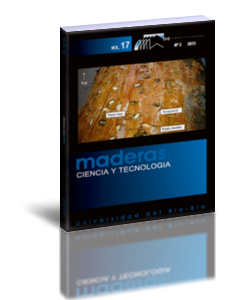Utilization of temperature kinetics as a method to predict treatment intensity and corresponding treated wood quality: Durability and mechanical properties of thermally modified wood
Keywords:
control quality, decay resistance, heat treatment, mass loses, mechanical properties, temperature kineticsAbstract
Wood heat treatment is an attractive alternative to improve decay resistance of wood species with low natural durability. However, this improvement of durability is realized at the expense of the mechanical resistance. Decay resistance and mechanical properties are strongly correlated to thermal degradation of wood cells wall components. Mass loss resulting from this degradation is a good indicator of treatment intensity and final treated wood properties. However, the introduction of a fast and accurate system for measuring this mass loss on an industrial scale is very difficult. Nowadays, many studies are conducted on the determination of control parameters which could be correlated with the treatment conditions and final heat treated wood quality such as decay resistance. The aim of this study is to investigate the relations between kinetics of temperature used during thermal treatment process representing heat treatment intensity, mass losses due to thermal degradation and conferred properties to heat treated wood. It might appear that relative area of treatment temperature curves is a good indicator of treatment intensity. Heat treatment with different treatment conditions (temperature-time) have been performed under vacuum, on four wood species (one hardwood and three softwoods) in order to obtain thermal degradation mass loses of 8, 10 and 12%. For each experiment, relative areas corresponding to temperature kinetics, mass loss, decay resistance and mechanical properties have been determined. Results highlight the statement that the temperature curves’ area constitutes a good indicator in the prediction of needed treatment intensity, to obtain required wood durability and mechanical properties such as bending resistance and Brinell hardness.
Downloads
Downloads
Published
How to Cite
Issue
Section
License
Copyright (c) 2015 K. Candelier, S. Hannouz, M. Elaieb, R. Collet, S. Dumarçay, A. Pétrissans, P. Gérardin, M. Pétrissans

This work is licensed under a Creative Commons Attribution 4.0 International License.
Los autores/as conservarán sus derechos de autor y garantizarán a la revista el derecho de primera publicación de su obra, el cuál estará simultáneamente sujeto a la Licencia de Reconocimiento de Creative Commons CC-BY que permite a terceros compartir la obra siempre que se indique su autor y su primera publicación esta revista.
































